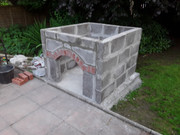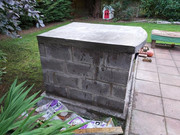scotsoven
valid member
  now have a usable oven
now have a usable oven
Posts: 28
|
Post by scotsoven on Jul 16, 2019 19:41:05 GMT
HI All, my name is Alan. Just started my build in June after reading alot about ovens on hear and other sites for the last few years. Have cast my base built my four walls with dense blocks and completed the wood store arch. Was going to go down the route of casting vermiculite dome over sand or a gym ball but after getting to this stage i am now wondering if this is a good idea??? Have put a few weeks work in (nights & weekends) to get to this far. Has anyone had good results with this method and how long has your oven lasted?  |
|
|
|
Post by downunderdave on Jul 18, 2019 20:09:32 GMT
HI All, my name is Alan. Just started my build in June after reading alot about ovens on hear and other sites for the last few years. Have cast my base built my four walls with dense blocks and completed the wood store arch. Was going to go down the route of casting vermiculite dome over sand or a gym ball but after getting to this stage i am now wondering if this is a good idea??? Have put a few weeks work in (nights & weekends) to get to this far. Has anyone had good results with this method and how long has your oven lasted?  You’ve done a very nice job so far. IMO a vermicrete dome is a poor design. The material is very weak resulting in vulnerability from bumps and abrasions. In addition being very insulative it has no ability to store heat (low thermal mass). This means you cannot do retained heat cooking. As Portland cement does not cope well with temps exceeding 300C the longevity of the mix is also in question. Despite repeated requests from builders who have tried this design I’ve not read of any reports of their long term success. I suspect they all fail. If you want to cast a cheap dome that does work and has long term success a home brew (3:1:1:1 sand, cement, hydrated lime, powdered clay) mix is a far better option. It will produce a dense durable casting with sufficient thermal mass, and just enough refractory properties to withstand our cooking temps. A better but much more expensive material is castable refractory, a calcium aluminate based mix able to handle much higher temps, available from refractory suppliers. A sand dome covered with strips of wet newspaper is a far easier mould than a gym ball as it allows the casting to be done in situ rather than building formwork to cast the top half of the ball and then having to move it into place after casting and demoulding. |
|
scotsoven
valid member
  now have a usable oven
now have a usable oven
Posts: 28
|
Post by scotsoven on Jul 24, 2019 20:20:37 GMT
Hi Dave, thanks for taking the time to reply have been doing a bit more reading and i think i might go down the route of castable refractory or go the whole hog and buy a dome from www.woodfire-gourmet.co.uk looks a good solid product. Have put 50 x 50mm angle iron in and got some old roofing sheet cut to allow me to pour the base at he weekend. See pictures
 |
|
sean
valid member
 
Posts: 63
|
Post by sean on Jul 30, 2019 21:15:33 GMT
welocme to the forum mate, looks good so far, i am also around the stage you are just trying to think of the next steps to take
|
|
|
|
Post by truckcab79 on Aug 2, 2019 6:52:27 GMT
Looks like you have a great start. I think I looked at the same supplier as you but eventually went with the supplier below. No connection to me other that I’m very happy with it and there are a few other builds for the same model recently on here. Search ‘Milano 750’ and I think there are three or four recent builds including mine. www.pizzaovensupplies.co.uk/ |
|
scotsoven
valid member
  now have a usable oven
now have a usable oven
Posts: 28
|
Post by scotsoven on Aug 8, 2019 20:55:36 GMT
Hi, thanks for the coments have now cast the harth base see pics and working on my vermiculite base. Contacted www.woodfire-gourmet.co.uk to see about the dome but they are not casting any just now as they are having some time off. So have read somemore and i am gojng down the homebrew mix route. Have bought some fireclay, cement, hydrated lime and sand to go with a 1,1,1,3 mix. Can someone please clarify is this ratio based on volume or weight? How long do you get to work with a mixed batch? Should you mix smaller batches as you go or mix a bigger batch? Have worked out i need 105kg in total for a 750mm dome 50mm thick 0.89M2 area if i have done my mathes right. Any advice would be greatly appreciated.   |
|
|
|
Post by oblertone on Aug 9, 2019 19:04:10 GMT
The homebrew ratios are by volume; as to 'how much' it's pretty forgiving stuff and doesn't go off too quickly so the biggest batch you're happy to work with.
|
|
|
|
Post by downunderdave on Aug 10, 2019 5:27:33 GMT
The homebrew ratios are by volume; as to 'how much' it's pretty forgiving stuff and doesn't go off too quickly so the biggest batch you're happy to work with. Proprietary castable refractories contain fibres that burn out at low temperature leaving behind a network of tiny pipes which help elimination of moisture to reduce steam spalling in the early fires required to drive out that moisture. As your homemade castable does not contain these it is prudent to add them. If you source the very fine polypropylene fibres used in a two pack concrete reinforcing product and add around 100 ml for every 10 litres of castable, mix them in well for good dispersal, they will add a level of protection. I use Novomesh 950 (the fine fibres only) |
|
scotsoven
valid member
  now have a usable oven
now have a usable oven
Posts: 28
|
Post by scotsoven on Aug 17, 2019 11:02:22 GMT
|
|
|
|
Post by oblertone on Aug 17, 2019 12:49:06 GMT
A cheap gazebo from Argos or eBay probably won't last a Scottish winter, but it will allow you to get something done ! As to the soldier course, sounds like a good idea, but don't forget the ratio between the door height and inside dome, it should be 63% or as close as you can get it.
|
|
scotsoven
valid member
  now have a usable oven
now have a usable oven
Posts: 28
|
Post by scotsoven on Aug 24, 2019 17:32:59 GMT
|
|
|
|
Post by downunderdave on Aug 24, 2019 20:08:27 GMT
That looks pretty good. You need to keep it moist for a week to enhance strength.
The problem with adding 10:1 vermicrete insulation directly over the dome is that the large amount of water it contains, when turned to steam can make it swell and crack. If this water is not eliminated then the swelling can crack the outer shell. To assist drying you can do the vermicrete in layers of around an inch and a half thick and allow a week drying (weather permitting) between layers.
|
|
scotsoven
valid member
  now have a usable oven
now have a usable oven
Posts: 28
|
Post by scotsoven on Aug 25, 2019 7:52:26 GMT
Thanks Dave keeping it moist wont be a issue here in scotland, is it best to leave the sand cast in for the week aswell?
|
|
|
|
Post by oblertone on Aug 25, 2019 11:27:39 GMT
I'm no expert on cast domes, but leaving the sand former in place will inhibit the drying process; as soon as you're confident that it won't fall down then I'd be digging out the sand. As to keeping it moist, I'd suggest an impermeable barrier (plastic sheet) draped over it rather than adding more water externally.
|
|
|
|
Post by downunderdave on Aug 25, 2019 20:33:52 GMT
Thanks Dave keeping it moist wont be a issue here in scotland, is it best to leave the sand cast in for the week aswell? No, remove the sand after 24 hrs to allow casting to shrink a little without placing stress on it. Cover for a week. |
|